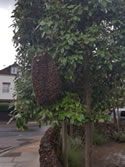The honey bee ‘swarming months’ have begun
By Julie Hill, Twickenham Beekeeper
The honey bee ‘swarming months’ have begun. Many readers may have seen a swarm hanging from a tree branch but swarms can gather on just about anywhere – cars / lamp posts / sides of buildings and even shop windows – who remembers the swarm on the Top Shop window in Oxford Street which caused much excitement – and trepidation - amongst shoppers?! As Urban beekeepers, we have an obligation to try to prevent swarming or collect swarms as quickly as possible and thus minimise any nuisance they may cause.
As such beekeeping can at times be a very challenging hobby. One hive can very quickly become, two then three and so there is a fair amount of management to be done particularly during April – July which is the peak swarming time.
Honey bees swarm because there is congestion in the hive and they need more space and also as a natural method of reproduction, when the Queen is old (3-5 years) and laying less eggs. The colony splits in two – or sometimes continues to split until you have hardly any bees left. The first main swarm is known as a Prime Swarm and subsequent smaller swarms are known as Castes. Swarms can also be triggered by lack of space in the hive, so beekeepers need to make weekly and careful inspections of their bees during this period, adding more frames and boxes is necessary to ensure they have enough space (a Queen can lay up to 2,000 eggs in a day) and to also check if the bees are creating ‘Queen Cells” to raise new Queens. If this happens, some form of “artificial swarm” must be done, which basically tricks the bees into thinking they have swarmed. This will result in another hive (although the two can be combined at a later date and the old Queen dispatched (freezing is the kindest way).
If a Queens Cell is missed during an inspection and thus allowed to grow, a swarm will be issued on the first dry warm day after the Queen Cell is capped.
When in ‘swarm mode’ the Queen and most of the flying bees will initially fly out in a huge mass and settle nearby, whilst ‘scout’ bees go off in search of a new home. This process can take several hours. Members of the public should ring their local apiary to report a swarm and a “swarm alert” is sent out to beekeepers and the swarm is allocated to and collected by the first beekeeper to respond. Once the ‘scout’s bees have found somewhere, they indicate to the hanging bees, encouraging others to do the same. Once a consensus is reached, the bees will take off. Beekeepers therefore have to act quickly one a swarm is reported. 
This photograph shows a large ‘prime’ swarm that I collected from a garden in Twickenham last year.
Not every report of bee swarms turn out to be honey bees though and often a cluster of bees in a garden is found to be a bumble bee nest in an empty bird box. More information about this can be found here:
https://bumblebeeconservation.org/about-bees/habitats/bumblebee-nests/
I encourage readers to go along to their local Apiary open days, where they can find out more about beekeeping
. Our next Open Day, is on Saturday 3rd June from 1pm. Come early if you would like to buy local honey as supplies sell out fast!
More information about Twickenham & Thames Valley Beekeeping Association in Whitton Road, Twickenham can be found here:
http://twickenhambeekeepers.apps-1and1.net/
